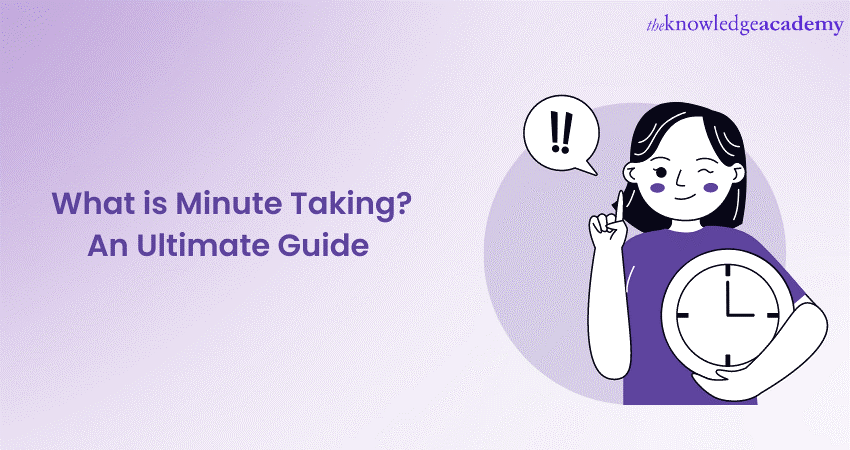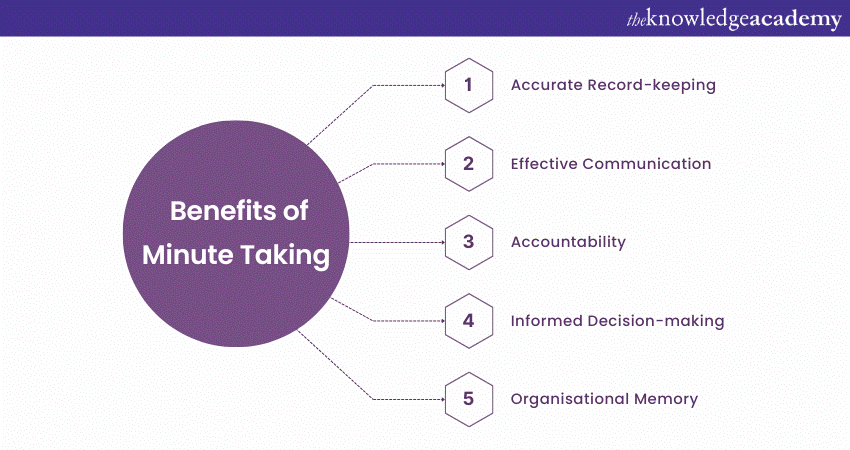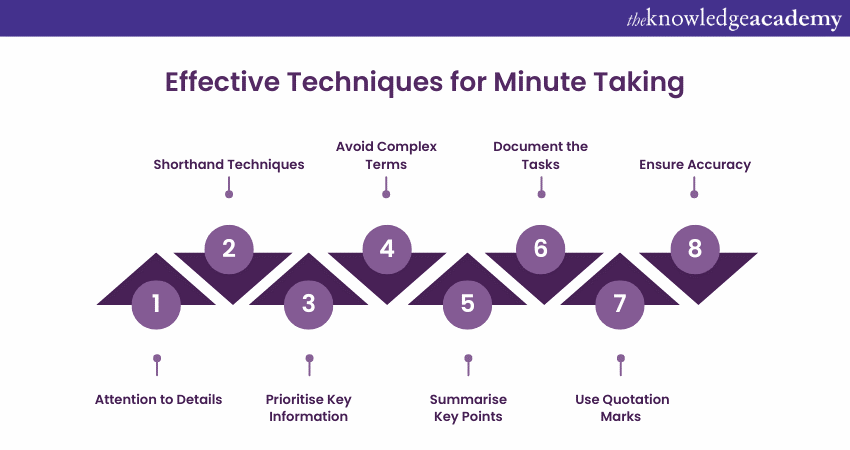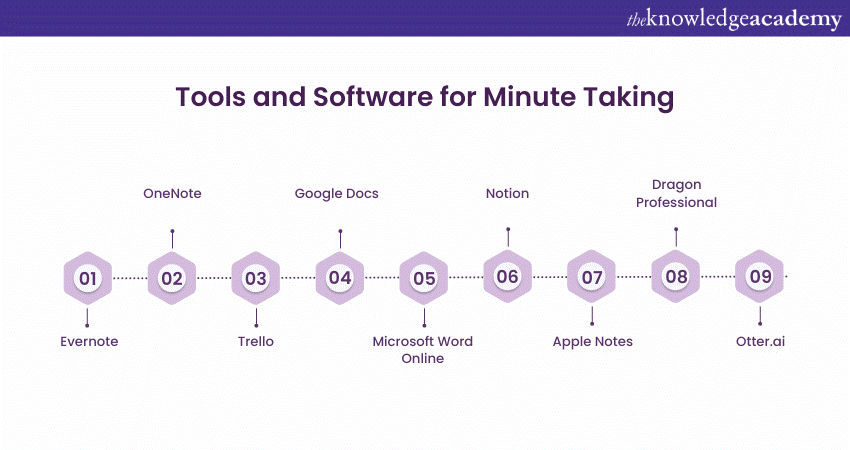We may not have the course you’re looking for. If you enquire or give us a call on +1 7204454674 and speak to our training experts, we may still be able to help with your training requirements.
We ensure quality, budget-alignment, and timely delivery by our expert instructors.

Are you tired of meetings that seem to drag on forever, only to realise later that crucial information was missed or forgotten? Imagine a world where every meeting runs smoothly, and all important details are captured accurately. Minute Taking can transform your meetings by ensuring clear, comprehensive documentation.
This essential skill involves active listening, precise note-taking, and effective organisation. In this blog, you’ll discover the significance of Minute Taking and learn techniques and tools to enhance your meeting Minutes. Say goodbye to chaos and hello to productivity!
Table of Contents
1) Highlighting What is Minute Taking?
2) Skills Required for Effective Minute Taking
3) The Importance of Minute Taking
4) Effective Techniques for Minute Taking
5) Tools and Software for Minute Taking
6) Tips to Share and Distribute Minutes
7) Conclusion
Highlighting What is Minute Taking?
Minute Taking is the process of capturing and recording the essential details of a meeting, including discussions, decisions, and action items. It serves as an official record and reference for all participants.
The primary purpose of Minute Taking is to ensure accurate documentation of meeting proceedings. By capturing key points, agreements, and action items, it provides a comprehensive overview of the discussions and decisions made. This helps attendees recall essential details, serves as a historical record, and facilitates follow-up actions.
Roles and Responsibilities of a Minute Taker
The Minutes Taker plays a critical role in taking Minutes of a meeting. They ensure that the meeting's key points, decisions, and action items are accurately recorded and documented. Here are their roles and responsibilities below:
The Roles of a Minute Taker:
a) Capturing all significant points discussed during the meeting
b) Structuring the notes in a clear and logical manner
c) Ensuring the minutes are easily understood by all stakeholders
d) Confirming the accuracy of recorded information before finalising the Minutes
e) Monitoring and noting the timing of key discussions and decisions
Responsibilities of a Minutes Taker
The Minutes Taker plays a critical role in taking Minutes of a meeting. Their responsibilities include:
a) Actively listening and observing during the meeting
b) Taking thorough notes
c) Organising the information clearly and concisely
They must be attentive to important details, such as names, decisions, deadlines, and other relevant information.
Skills Required for effective Minute Taking
You should possess some essential Minute Taking Skills to ensure accurate and comprehensive documentation of meetings. Let's look at some of them below:
a) Active listening: The ability to focus on and comprehend the speaker's message. It involves paying attention, clarifying uncertainties, and capturing the main points accurately.
b) Note-taking: Efficient note-taking is a crucial skill for a Minutes Taker. They must develop shorthand techniques, use bullet points, and adopt a structured format to record information quickly and effectively.
c) Organisation and structure: A Minutes Taker should possess organisational skills to arrange information logically. They must categorise discussions, decisions, and action items under appropriate headings to ensure the Minutes are easy to navigate and comprehend.
d) Scope of Minute-Taking: Minute Taking is not limited to business meetings. It is equally vital in various settings, including academic institutions, nonprofit organisations, government bodies, and community gatherings. Regardless of the context, Minute Taking serves the essential purpose of capturing vital information and ensuring transparency.
Level up your career as an Executive Personal Assistant with our Perfect Executive Personal Assistant Training - join now!
The Importance of Minute Taking
Minute Taking is fundamental in any meeting or gathering, and its importance cannot be overstated. The following points explain the importance of Minute Taking:

Effective Decision-making
Accurate and well-documented Minute Taking provides a reliable reference for decision-making processes. Minutes capture the discussions, ideas, and arguments exchanged during the meeting, allowing participants to refer when making decisions. By having a clear record of the meeting's proceedings, individuals can ensure that decisions align with the agreed-upon objectives and priorities.
Accountability and Responsibility
Minutes act as a tool to establish accountability among meeting participants. When actions and responsibilities are assigned and recorded in the Minutes, individuals are likelier to follow through on their commitments. This fosters a sense of responsibility and ensures everyone remains accountable for contributing to the meeting's outcomes.
Historical Reference
Minutes serve as a historical record of meetings. They document the evolution of ideas, the decision-making process, and the actions taken over time. This historical reference can be invaluable for tracking progress, evaluating the effectiveness of past decisions, and providing context for future discussions.
Legal and Compliance Requirements
Minute Taking is legally required in specific contexts, such as corporate board meetings or official government gatherings. Adhering to certain regulations and compliance standards ensures transparency, protects stakeholders' rights, and mitigates legal risks. Moreover, well-documented and accurately recorded Minutes indicate due process and adherence to legal requirements.
Communication and Transparency
Minutes are a means of communication between meeting participants and those who cannot attend. They summarise the discussions, decisions, and action items, enabling individuals to stay informed and involved even if they are not physically present. Moreover, transparent and accessible minutes promote trust and openness within the organisation or group.
Reflection and Improvement
By reviewing past Minutes, individuals and organisations can reflect on their meeting practices, identify areas for improvement, and refine their decision-making processes. Furthermore, it offers valuable insights into the effectiveness of meetings, allowing for continuous growth and enhancement of collaborative efforts.
Effective Techniques for Minute Taking
Taking accurate and comprehensive Minutes requires specific techniques to ensure the quality and clarity of the captured information. Let's explore How to Take Minutes in a Meeting with some effective techniques in the following sections:

a) Listening: Listening involves fully engaging in the meeting discussions, paying attention to details, and accurately capturing the main points. For this, you must maintain focus, avoid distractions, and listen attentively to ensure you don't miss essential information.
b)Structured Note-taking: Develop a structured approach to note-taking that works best for you. Use headings, bullet points, and indentations to organise information logically. Use shorthand techniques or abbreviations for frequently used terms to speed up the note-taking process without compromising accuracy.
c) Key Information Prioritisation: Identify and prioritise critical information during the meeting. Focus on capturing decisions, action items, deadlines, and any other significant outcomes. Summarise discussions precisely, highlighting essential points and omitting irrelevant details.
d) Clear And Concise Language: Use clear and concise language in your Minutes. Avoid jargon and lengthy technical terms that may be unfamiliar to others. Ensure that your sentences are simple and easy to understand and convey the intended meaning accurately.
e) Active Summarisation: Practice active summarisation during the meeting. Summarise critical points periodically to confirm your understanding and provide an opportunity for clarification if needed. This ensures that your Minutes accurately reflect the essence of the discussions.
f) Capturing Action Items: Pay close attention to action items assigned during the meeting. Clearly document each action item's tasks, responsible individuals, and deadlines. This facilitates accountability and follow-up after the meeting.
g) Verbatim Quoting: In certain situations, it may be necessary to include verbatim quotes in the Minutes, especially for important decisions or controversial discussions. Use quotation marks and attribute the statements to the respective speakers. However, exercise discretion and only include verbatim quotes when they add value or clarity to the Minutes.
h) Review And Edit: Once the meeting concludes, review and edit your Minutes before finalising them. Ensure the accuracy of the captured information, correct any typos or grammatical errors, and organise the content logically. This step enhances the professionalism and readability of the Minutes.
By employing these effective techniques, you can elevate your Minute Taking skills and produce accurate, clear, and comprehensive Minutes.
Master the art of efficient note-taking with our Shorthand Training - Sign up today!
Tools and Software for Minute Taking
There are numerous tools and software available to enhance the Minute Taking process. These Minute Taking Tools offer features and functionalities that streamline the capturing, organising, and sharing of meeting Minutes. Let's explore some popular tools and software options in the following sections:

Dedicated Minute Taking Applications
Several dedicated Minute Taking applications are designed specifically to simplify the process. These applications provide a user-friendly interface, customizable Minute Taking Templates, and convenient features for an efficient Minute Taking process. Some of the key examples include:
a) Evernote: A versatile note-taking application that allows you to easily create and organise meeting notes. It offers collaboration features, tagging options, and the ability to attach files and multimedia.
b) OneNote: A powerful digital note-taking app by Microsoft that enables you to create and organise meeting notes in a structured manner. It offers seamless integration with other Microsoft tools and platforms.
c) Trello: A project management tool that can be utilised for Minute Taking. It offers boards, cards, and checklists to capture meeting details and track action items effectively.
Enhance your note-taking skills and master productive meetings with our Minute Taking Training- Sign up today!
Collaborative Document Editors
Collaborative document editors are extremely useful tools for taking notes of meetings. They allow multiple participants to work on the same document simultaneously. These tools are particularly useful for capturing real-time meeting Minutes and facilitating collaboration. Some of the key examples include:
a) Google Docs: A popular cloud-based document editor that enables real-time collaboration. It provides features such as version history, comments, and the ability to share documents securely.
b) Microsoft Word Online: Microsoft Word's online version allows multiple users to edit a document simultaneously. It offers real-time collaboration features and extensive formatting options.
Download the Effective Minute-Taking PDF and improve your meeting skills today!
Note Taking Apps
Apps and Software for Minute Taking offer convenience and flexibility for capturing meeting Minutes on various devices. They often include synchronisation across devices and integration with other applications. Some of the key examples include:
a) Notion: A comprehensive note-taking app that allows you to create and organise meeting notes in a flexible and customisable format. It offers features such as tables, databases, and task management.
b) Apple Notes: The default note-taking app on Apple devices offers a simple and intuitive interface. It supports rich text formatting, attachments, and iCloud synchronisation.
Voice Recognition Software
Voice recognition software can be helpful for transcribing meetings or converting spoken notes into written text. These tools are primarily time-saving and foster accuracy. Some of the key examples include:
a) Dragon Professional: A powerful voice recognition software that enables you to dictate meeting Minutes and convert speech to text. It offers high accuracy and supports various languages.
b) Otter.ai: An AI-powered transcription and note-taking app that can automatically transcribe spoken words into text. It allows you to highlight key moments and search for specific content within the transcriptions, while also offering Transcription and Translation features for seamless multilingual support.
Unlock your typing potential with our Touch Typing Training Course- sign up now!
Tips to Share and Distribute Minutes
Once the meeting Minutes are prepared, sharing and distributing them is important to ensure that all relevant individuals have access to the information. Let's explore some best practices for sharing and distributing Minutes below:
a) Determine the Distribution List: Identify the individuals or groups needing the Minutes. This typically includes meeting participants, stakeholders, and anyone who requires the information documented in the Minutes for reference or action.
b) Choose an Appropriate Format: Select a format for the Minutes that is easily accessible and compatible with various devices and software. PDF is a commonly used format as it ensures the preservation of the document's layout and can be viewed on most devices.
c) Use Secure File-sharing Platforms: Consider using secure file-sharing platforms to distribute the Minutes. These platforms offer encryption and access controls, ensuring that confidential information remains protected. Some of the key examples include Google Drive and Microsoft OneDrive.
d) Email Distribution: Email remains a preferred method for sharing Minutes. When distributing Minutes via email, compose a concise and informative message highlighting the email's purpose. Include a summary of key points from the meeting. Attach the minutes in the chosen format (e.g., PDF) and use a descriptive subject line indicating the meeting date, purpose, and "Minutes" for easy reference.
e) Centralised Document Repository: Consider establishing a centralised document repository where all meeting Minutes are stored and accessible to authorised individuals. This can be a shared drive, intranet portal, or a dedicated document management system. Make sure to maintain proper organisation and version control for easy retrieval and reference.
f) Follow-up Communication: After distributing the Minutes, sending a follow-up communication to the recipients is an added bonus.This can serve as a reminder to review the Minutes, address any questions or concerns, and emphasise the importance of taking necessary actions based on the meeting outcomes.
Enhance your career with Reception Skills Training to excel in communication, customer service, and organisation.
Conclusion
We hope you found this blog on Minute Taking informative and insightful. Effectively noting the records is crucial for accurately capturing the meeting's outcomes. By mastering key skills and utilising tools, Minute Takers can contribute to clear and valuable documentation, aiding future reference and decision-making.
Unlock your potential and become a master in secretarial skills with our comprehensive Secretarial Course – Sign up now!
Frequently Asked Questions
What are the Guidelines for Minute Taking?

You must listen actively, capture crucial points, and record decisions, actions, and attendees. Additionally, organise Minutes logically with headings. Review and edit multiple times for accuracy. Lastly, distribute promptly to relevant parties, maintain confidentiality, and following organisational standards.
What is the 3-minute Meeting Rule?

The 3-minute Meeting rule suggests that each participant should speak for only three minutes at a time. This ensures concise communication, keeps the meeting on track, and allows everyone an equal chance to contribute. Moreover, it promotes efficiency and helps prevent lengthy, off-topic discussions.
What are the Other Resources and Offers Provided by The Knowledge Academy?

The Knowledge Academy takes global learning to new heights, offering over 3,000 online courses across 490+ locations in 190+ countries. This expansive reach ensures accessibility and convenience for learners worldwide.
Alongside our diverse Online Course Catalogue, encompassing 19 major categories, we go the extra mile by providing a plethora of free educational Online Resources like News updates, Blogs, videos, webinars, and interview questions. Tailoring learning experiences further, professionals can maximise value with customisable Course Bundles of TKA.
What is The Knowledge Pass, and How Does it Work?

The Knowledge Academy’s Knowledge Pass, a prepaid voucher, adds another layer of flexibility, allowing course bookings over a 12-month period. Join us on a journey where education knows no bounds.
What are the Related Courses and Blogs Provided by The Knowledge Academy?

The Knowledge Academy offers various PA and Secretarial Courses including the Minute Taking Training and Administrative Assistant Trainings, among other reputed programs. These courses cater to different skill levels, providing comprehensive insights into Minute Taking Techniques and Tips.
Our Business Skills Blogs cover a range of topics related to the importance of Minute Taking, offering valuable resources, best practices, and industry insights. Whether you are a beginner or looking to advance your Business Management skills, The Knowledge Academy's diverse courses and informative blogs have got you covered.
Upcoming Business Skills Resources Batches & Dates
Date
 Company Secretary Training Course
Company Secretary Training Course
Fri 11th Apr 2025
Fri 13th Jun 2025
Fri 8th Aug 2025
Fri 26th Sep 2025
Fri 21st Nov 2025






 Top Rated Course
Top Rated Course



 If you wish to make any changes to your course, please
If you wish to make any changes to your course, please


